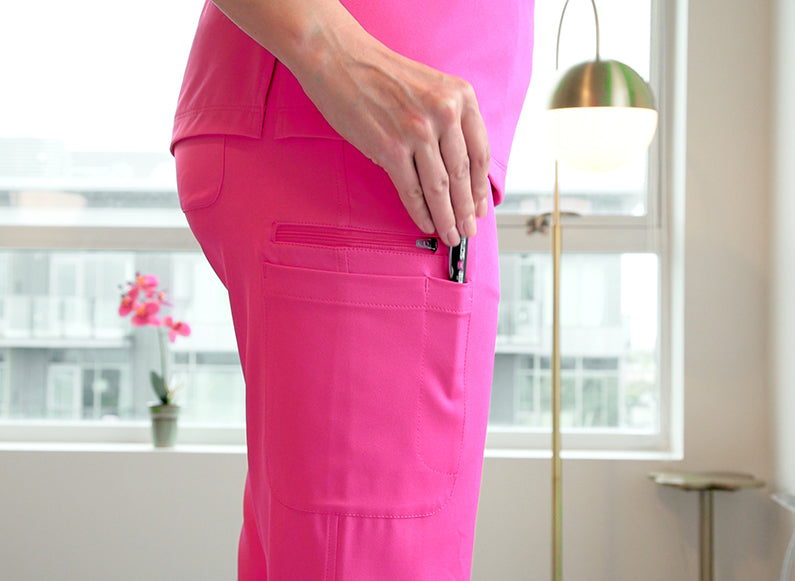Written by Sarah S. Falcone BSN, RN
A mentor once told me something that has remained with me to this day: Nurses either love home health or hate it. With over a decade spent as a homecare nurse, I’d say this statement is 99.99% accurate.
Indeed, homecare takes a special type of nurse; we face both unique challenges and enjoy matchless rewards.
If you’ve ever wondered about homecare, read on to find out more about the daily routines of a homecare nurse.
What are the Responsibilities of Homecare Nurses?
Homecare nurses provide direct care to patients with disabilities or chronic conditions in the comfort of their homes. RNs (in their favorite medical scrubs) perform clinical assessments, home safety evaluations, hands-on nursing skills, and interdisciplinary care coordination. They practice a wide range of nursing skills including:
-
Wound care
-
Intravenous (IV) therapy
-
Urinary catheter maintenance
-
Tracheostomy care
-
Enteral nutrition
-
Education
The homecare patient population is trending toward higher acuity, requiring more interventions performed in the home each day. The healthcare system is focused on better outcomes at lower costs, therefore making homecare an appealing option. Hospitals can discharge patients faster, allowing patients to heal at home while supervised by community doctors and in-home nurses and therapists.
Homecare nurses work for hospital networks, private organizations, or individuals who pay out of pocket. Most home care providers in the U.S. are private for-profit agencies.
Rewards for Home Care Nurses
There are many reasons why nurses find homecare extremely rewarding. For nurses who enjoy teaching, homecare provides an opportunity to educate patients and families without the interruptions or time constraints of a busy hospital unit.
One study found that severe stress related to hospitalization and acute illness consistently lead to poor retention and recall of discharge instructions. Patients are more receptive to teaching in their homes, and they tend to remember more, which leads to better health outcomes.
Homecare nurses develop long-lasting relationships with their patients and families, allowing for repeated follow-ups and evaluations. Patients tend to relax in their homes, letting us get to know more about our patients in a hospital or outpatient clinic. Nurses who are passionate about patient care enjoy this dynamic.
In homecare, nurses can impact patients in major ways. They see first-hand how patients live, where they sleep, what they eat, and who helps them. Homecare workers can implement big changes with lasting effects.
Other perks to homecare include flexible schedules, autonomy, and variety. There is always something new to learn, see, or do.
Challenges for Homecare Nurses
It would be dishonest to say that homecare is always an uplifting and positive experience. Here are a few challenges in home health.
Working in a stranger’s home is very different from working in a hospital. It takes time to acquire specific supplies and equipment, and you usually have to buy your own medical scrubs uniform. There are no coworkers readily available to lend a second set of hands or eyes. Moreover, most patient homes don’t have a cleaning service, and the state of patients’ homes can vary widely from clean and organized to dirty and cluttered. Nurses must learn to navigate sanitation, infestation, and safety issues.
Another challenge homecare nurses face is caring for patients with a lack of, or limited, support. Patients may have severe disabilities, hearing deficits, and vision impairments. Often, their loved ones experience caregiver burnout and depend on the homecare nurse for help.
Patients come from all backgrounds. Many have religious, cultural, and social considerations nurses must be aware of. For example, some families ask nurses to remove their shoes to enter the home. Others cannot be available for home visits during times dedicated for prayer or fasting. Homecare nurses must be sensitive to all patients’ beliefs.
A recent study of home health nurses found that sexual orientation and gender identity are difficult subjects to navigate in a sensitive and competent manner. Although not unique to homecare, these can be more delicate topics when a nurse is working in the patient’s home.
In home healthcare, nurses are invited into their patients’ daily lives. Relationships remain professional, but conversations tend to be more personal. Patients are able to trust the home care nurse with valuable information, which ultimately helps nurses and doctors with care plans and treatment decisions. One important example of this is care for patients in the LGBTQ+ community. Health disparities in the lesbian, gay, bisexual, and transgendered populations are concerning, and home care nurses are uniquely positioned to address their health needs.
Day in the Life
Homecare nursing is not for everyone. But despite these issues, as my mentor said, some nurses love it! Let’s look at an average Day In The Life (DITL).
20:00 - A DITL of a homecare nurse starts the night before! Seasoned nurses know to confirm appointments in advance. Many homecare nurses make their own schedules. When patients cancel at the last minute, nurses must rearrange their routes.
09:00 – The first visit is an admission visit, known as the “Start of Care (SOC)” for an elderly female patient, post-hospital discharge with pneumonia. The visit includes consents, assessment with medication reconciliation, and teaching. It takes approximately two hours.
11:00–11:35 - Drive to Patient #2, but stop to use a public restroom (one of the challenges of homecare).
11:35-12:35 - This is a routine wound care visit, called a “skilled visit” with an elderly diabetic male who has multiple diabetic foot ulcers (DFUs). He is blind and wheelchair-dependent, without a caregiver to change his dressings. The visit includes a blood sugar check, wound measurements with photos, and dressing changes. It takes approximately one hour.
12:35-13:10 - Drive to Patient #3 with lunch in the car. Home health nurses usually avoid heavy meals (see 11:00).
13:10-13:15 - Arrive at Patient #3’s house. Knock on the door three times with no answer. Call Patient #3, and she answers with, “Oh, honey, I’m in the emergency room.” During the night, her daughter took her to the hospital. They forgot to notify you. You send a HIPAA-compliant text to your Team Leader to report Patient #3 is at the ER.
13:15-13:35 - Drive to the office. Since you’re close, you decide to pick up supplies you need for tomorrow. Then you phone Patient #4 to ask if you can come early. The patient is agreeable.
13:35-13:45 - Drive to Patient #4.
13:45-15:45 - This visit is another SOC. Patient #4 is status-post lumbar laminectomy for spinal stenosis and needs home physical therapy. During medication reconciliation, you discover that he has not picked up new medications from the pharmacy. You provide education and let him know you will call in the morning to make sure he starts the medication. After completing the assessment and teaching, it's time to go home for the day.
15:45-16:10 - Drive home.
16:20-18:20 - Finish charting and call patients for tomorrow.
A DITL of a homecare nurse might be challenging, but it will always be rewarding. If a career in home health sounds interesting, consider a part-time or PRN position to develop the homecare skills you need.
You may just love it.
References
https://my.clevelandclinic.org/health/diseases/9225-caregiver-burnout
https://www.cdc.gov/nchs/fastats/home-health-care.htm
https://www.osha.gov/home-healthcare
https://jamanetwork.com/journals/jamainternalmedicine/article-abstract/2727848
https://journals.plos.org/plosone/article?id=10.1371/journal.pone.0197831
https://pubmed.ncbi.nlm.nih.gov/31815599/
https://www.ncbi.nlm.nih.gov/pmc/articles/PMC3722540/
About the Author:

Sarah S. Falcone BSN, RN, is a writer in Fort Worth, TX. She’s worked in a variety of settings including Med-Surg and L&D, but Home Health has her heart. After 15 years in patient care and nursing leadership, she started writing to share her nursing experiences and expertise online. She writes best with a hot cup of coffee and a Lofi hip hop playlist. You can connect with her on LinkedIn!





